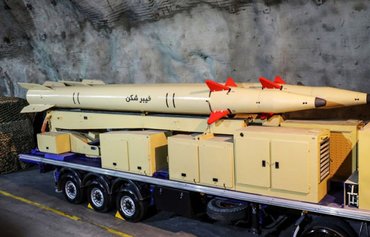Iran's recent missile programme expansion is a regional and international provocation that is also draining the country's already tattered economy at the expense of its citizens, experts told Al-Mashareq.
The cost of the missile programme has been foisted on the Iranian people, who are already suffering economic distress as Iran pursues its expansionist agenda.
Iran's Islamic Revolutionary Guards Corps (IRGC) on Thursday (February 7th) unveiled a new ballistic missile, "Dezful", with a range of 1,000 kilometres, AFP reported. The surface-to-surface missile is an upgrade of the Zolfaghar model.
A few days earlier, on February 2nd, Iran said it had successfully tested a new cruise missile, "Hoveizeh", with a range of 1,350 kilometres.
![Iran announced on February 2nd that it had successfully tested the Hoveizeh cruise missile at a range of 1,200 kilometres. [Photo circulated on social media]](/cnmi_am/images/2019/02/12/16594-Iran-missile-Hoveizeh-600_384.jpg)
Iran announced on February 2nd that it had successfully tested the Hoveizeh cruise missile at a range of 1,200 kilometres. [Photo circulated on social media]
![The Iranian people are paying the price for the IRGC’s missile production ambitions as they see their economic conditions deteriorate markedly. [File]](/cnmi_am/images/2019/02/12/16638-irgc_missile_cost-600_384.jpg)
The Iranian people are paying the price for the IRGC’s missile production ambitions as they see their economic conditions deteriorate markedly. [File]
"The test of the Hoveizeh cruise missile was carried out successfully at a range of 1,200 kilometres and accurately hit the set target," Defence Minister Amir Hatami said, quoted on state television which broadcast footage of its launch.
"It can be ready in the shortest possible time and flies at a very low altitude," he said, describing the Hoveizeh as the "long arm of the Islamic Republic of Iran".
The Hoveizeh is part of the Soumar group of cruise missiles, first unveiled in 2015 with a range of 700 kilometres, the minister said.
IRGC commander Maj. Gen. Mohammad Ali Jafari and aerospace commander Brig. Gen. Amirali Hajizadeh unveiled the new weapons at an "underground ballistic missile production facility", Iranian media reported.
Iranian people pay the price
"To develop its missile capabilities, Iran is spending money from the sovereign resources and wealth of the Iranian people," said al-Sharq Centre for Regional and Strategic Studies researcher Fathi al-Sayed.
The missile programme, which includes the upgrade of old missiles and the development of new ones, "requires a lot of money", he told Al-Mashareq, adding that the Iranian people "are paying the price for the IRGC’s ambitions".
"The Iranian people have seen their economic conditions deteriorate markedly, as evident from the popular uprisings that have swept through most cities in Iran and continue to do so," al-Sayed said.
Violent protests that broke out in Iran in late 2017 to protest the dire state of the economy "were met with suppression and media blackout by internal security forces like the Basij and others", he said.
Despite Iran's claims to the contrary, he said, the missile programme is not intended for defence, but "has more to do with the IRGC’s expansionist plans and the support it provides to the military arms it established to implement those plans".
Missiles pose 'serious threat'
"Iran's blatant disregard for international norms must be addressed," US State Department deputy spokesman Robert Palladino said in a February 7th statement following the new ballistic weapon introduction and cruise missile test.
"We must bring back tougher international restrictions to deter Iran's missile programme," he said.
"The US will continue to be relentless in building support around the world to confront the Iranian regime's reckless ballistic missile activity, and we will continue to impose sufficient pressure on the regime so that it changes its malign behaviour - including by fully implementing all of our sanctions."
In parallel to developing its missile programme, Iran is waging a provocative media campaign that seeks to defy western countries and the US in particular, said Sheyar Turko, who has been researching the financing of the IRGC.
Iran's continued efforts to increase the range and precision of its missiles and increase the number of tests and operational launches deepen mistrust and contribute to regional instability, the EU said in a February 4th statement.
Arms factories in IRGC hands
The most serious aspect of the Iranian missiles issue is the transfer of the manufacture or assembly process to factories overseen by IRGC officers in countries such as Yemen, Syria and Lebanon, Turko told Al-Mashareq.
These factories will "ultimately be in the hands of IRGC-affiliated armed groups in those countries", he said, noting that it would be impossible for these countries to exercise sovereignty under these circumstances.
"Iran is testing ballistic missiles under the guise of testing satellite-bearing missiles to evade accusations of violating UN resolutions and the imposition of new sanctions," security expert Abdul Karim Ahmed told Al-Mashareq.
Ahmed warned of the medium-range surface-to-surface missile system that does not require much technical precision to manufacture and is supplied by Iran to its military proxies in the region, saying these pose "a constant threat".
"Iran has also developed anti-tank Toophan missiles series, most notably the Touphan 3 and Toophan 7 missiles," he said.
The Iranian people "foot a very hefty bill for the missile programme which has [adversely] impacted their economic situation", he added.

![Iran's Zolfaghar short-range missile is displayed during an IRGC military parade in Tehran. [Photo circulated on social media]](/cnmi_am/images/2019/02/12/16593-Iran-missile-parade-600_384.jpg)






Who owns this idiotic pages
Reply2 Comment(s)
Far less than the payment to the US for its protection by the Gulf Dwarves!!!
Reply2 Comment(s)